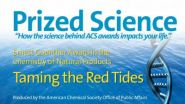(Press-News.org) Rising concentrations of zinc in a waterway on Colorado's Western Slope may be the result of climate change that is affecting the timing of annual snowmelt, says a new study led by the University of Colorado at Boulder.
The study focused on the Snake River watershed just west of the Continental Divide near Keystone, Colo., where CU-Boulder researchers have observed a four-fold increase in dissolved zinc over the last 30 years during the lowest water flow months, said Caitlin Crouch. Crouch, a master's degree student who led the study, said the high levels of zinc affect stream ecology, including deleterious effects on microbes, algae, invertebrates and fish.
The team speculated the increased zinc concentrations may be tied to changes in groundwater conditions and stream flow patterns caused by climate change and the associated snowmelt that has been peaking two to three weeks earlier than normal in recent years, largely because of warming air temperatures. The result is lowered stream flows and drier soils along the stream in September and October, which increases metal concentrations, said Crouch.
"While most of the talk about climate change in western waterways is about decreasing water quantities, we are evaluating potential climate influences on water quality, which is a whole different ball game," she said.
Crouch gave a presentation on the subject at the fall meeting of the American Geophysical Union held in San Francisco Dec. 13-17. The study was co-authored by Professor Diane McKnight of CU-Boulder's civil and environmental engineering department.
The zinc in the Snake River watershed is primarily a result of acid rock drainage, or ARD, which can come from abandoned mine sites along rivers or through the natural weathering of pyrite in the local rock, said Crouch. Sometimes enhanced by mining activity, weathering pyrite forms sulfuric acid through a series of chemical reactions, which dissolves metals like zinc and carries them into the groundwater.
McKnight, also a fellow of CU-Boulder's Institute of Arctic and Alpine Research, said there are nearly 2,000 miles of waterways in Colorado affected by ARD.
One of the most noticeable impacts of ARD in the Upper Snake River drainage is on the fishery downstream, said Crouch, a graduate student in CU-Boulder's Environmental Studies Program. Rainbow trout populations in much of the river are not self-sustaining because of ecologically harsh stream conditions, and the waterway requires stocking several times a year.
The elevated zinc in the Snake River comes from several ARD sources, said Crouch. Crouch's study site -- where an increasing trend in zinc concentrations is sustained by groundwater discharge -- is above the Peru Creek tributary to the Snake River, where natural pyrite weathering is thought to be the main source of ARD. Peru Creek is largely devoid of life due to ARD from the abandoned Pennsylvania Mine and other smaller mines upstream and has been a target for potential remediation efforts.
McKnight said another factor involved in rising zinc levels in the Snake River watershed -- which runs from the top of the Continental Divide to Dillon Reservoir -- could be the result of the severe 2002 drought in Colorado. The drought significantly lowered waterways, allowing more pyrite to be weathered in dry soils of the watershed and in wetlands adjacent to the stream.
As part of her study, Crouch measured zinc concentrations in an alpine tributary of the Upper Snake River. She found that zinc concentrations there were 10 times higher than in the main stem of the waterway and correlated with increased sulfate, so-called "hard water" containing calcium and magnesium, and a variety of metals.
"This supports our contention that the increasing zinc concentrations we are seeing in the watershed are driven by the acceleration of ARD," Crouch said. "One of the things I still am trying to parse out is whether metals like zinc are coming from one discrete source or are being diffused into the watershed from the groundwater beneath."
Cleaning up abandoned, polluted mines like the Pennsylvania Mine remains a problem largely because of liability issues since the mine owners who normally would be responsible for the mine cleanup are long gone. The Environmental Protection Agency has begun an agency-wide effort to reduce barriers to the cleanup of abandoned mine sites by local environmental groups and volunteers.
In the case of the Pennsylvania Mine, the Snake River Task Force is working with partners like the Keystone Ski Resort, the Keystone Center, Trout Unlimited, the Northwest Colorado Council of Governments, Summit County, the Colorado Department of Public Health and Environment, the EPA and the Blue River Watershed Group.
INFORMATION:
Seven CU-Boulder graduate students have produced master's and doctoral theses under McKnight on environmental issues related to the Snake River watershed. Copies of the studies have been provided to the Snake River Task Force to help assess the current and future stream chemistry and biology in the area.
Elevated zinc concentrations in Colorado waterway likely a result of climate change
2010-12-16
ELSE PRESS RELEASES FROM THIS DATE:
Study improves understanding of method for creating multi-metal nanoparticles
2010-12-16
A new study from researchers at North Carolina State University sheds light on how a technique that is commonly used for making single-metal nanoparticles can be extended to create nanoparticles consisting of two metals – and that have tunable properties. The study also provides insight into the optical properties of some of these nanoparticles.
Tuning the optical properties of nanoparticles is of interest for applications such as security technology, and for use in making chemical reactions more efficient – which has multiple industrial and environmental applications. ...
New American Chemical Society Prized Science video on 'red tide' shellfish poisoning
2010-12-16
WASHINGTON, Dec. 15, 2010 — The quest to cure a terrible form of food poisoning caused by population explosions of algae that stain the water red and produce a potent toxin is the topic of a new episode in the American Chemical Society (ACS) Prized Science video series.
Entitled "Taming the Red Tides," the high-definition video, released today, focuses on Michael Crimmins, Ph.D., winner of the 2010 Ernest Guenther Award in the Chemistry of Natural Products. Crimmins, a chemist at the University of North Carolina in Chapel Hill, studies brevetoxin A, a poison produced ...
Study supports gluten-free diet in potential celiac disease patients
2010-12-16
Findings from a new study of 141 adults add to an ongoing medical debate over which patients with symptoms of celiac disease should go on a gluten-free diet. Published in ACS' Journal of Proteome Research, the study concludes that people currently diagnosed as "potential" celiac disease patients and not advised to follow a gluten-free diet may not be "potential" patients at all. Rather, the scientists found that these patients have the same distinctive metabolic fingerprint as patients with full-blown disease who do benefit from gluten-free diets.
In the study, Ivano ...
Does fluoride really fight cavities by 'the skin of the teeth?'
2010-12-16
In a study that the authors describe as lending credence to the idiom, "by the skin of your teeth," scientists are reporting that the protective shield fluoride forms on teeth is up to 100 times thinner than previously believed. It raises questions about how this renowned cavity-fighter really works and could lead to better ways of protecting teeth from decay, the scientists suggest. Their study appears in ACS' journal Langmuir.
Frank Müller and colleagues point out that tooth decay is a major public health problem worldwide. In the United States alone, consumers spend ...
Toxic toy crisis requires fresh solutions
2010-12-16
Manufacturer recalls of toys, promotional drinking glasses, and other children's products constitute an ongoing "toxic toys crisis" that requires banning potentially harmful ingredients in these products and other changes in policy and practices. That's the conclusion of a new analysis in ACS' journal Environmental Science & Technology.
Monica Becker, Sally Edwards and Rachel Massey note that in June the United States government recalled 12 million promotional drinking glasses sold at a fast-food restaurant chain because the painted coating contained cadmium, a toxic ...
Preteen conduct problems leads to teenage serious violence and delinquency
2010-12-16
Montreal, December 15, 2010 – Conduct disorders in preteens are predictive of eventual teenage serious violent and delinquent behavior, according to a new study from the Université de Montréal. The findings, published in this month's issue of Journal of Child Psychology and Psychiatry, have implications for concerned parents.
Preteens who steal, destroy property, fight and bully are six times as likely to sell illicit drugs, nine times as likely to join a gang, 11 times as likely to carry a weapon and eight times as likely to be arrested as a future teenager, according ...
Cilantro ingredient can remove foul odor of holiday chitlins
2010-12-16
With chitlins about to make their annual appearance on Christmas and New Year's Day menus, scientists have good news for millions of people who love that delicacy of down-home southern cooking, but hate the smell. They are reporting the first identification of an ingredient in cilantro that quashes the notoriously foul odor of chitlins — a smell known to drive people from the house when chitlins are cooking. Their report appears in ACS' Journal of Agricultural and Food Chemistry.
Yasuyoshi Hayata and colleagues note that chitlins — hog large intestines — are infamous ...
Bacterial life on and in humans orchestrates health and disease
2010-12-16
A mounting tide of scientific evidence suggests that the old adage from Aesop's fables — "You are known by the company you keep" — also applies to the trillions of microscopic bacteria and viruses that live on the human body. Humanity's invisible but constant companions — more bacteria hang out on the palms of your hands than there are people on Earth — is the topic of an article in the current edition of Chemical & Engineering News (C&EN), ACS' weekly newsmagazine.
C&EN Associate Editor Sarah Everts notes in the article that the astonishing diversity of microbes inhabiting ...
New discoveries make it harder for HIV to hide from drugs
2010-12-16
The virus that causes AIDS is chameleon-like in its replication. As HIV copies itself in humans, it constantly mutates into forms that can evade even the best cocktail of current therapies. Understanding exactly how HIV cells change as they reproduce is key to developing better tests and treatments for patients.
In the Journal of Biological Chemistry and Nature Structural & Molecular Biology, MU microbiologist and biochemist Stefan Sarafianos, PhD, reveals new findings that shed light on how HIV eludes treatment by mutating. His discoveries provide clues into HIV's mechanisms ...
Atomic weights of 10 elements on periodic table about to make an historic change
2010-12-16
For the first time in history, a change will be made to the atomic weights of some elements listed on the Periodic table of the chemical elements posted on walls of chemistry classrooms and on the inside covers of chemistry textbooks worldwide.
The new table, outlined in a report released this month, will express atomic weights of 10 elements - hydrogen, lithium, boron, carbon, nitrogen, oxygen, silicon, sulfur, chlorine and thallium - in a new manner that will reflect more accurately how these elements are found in nature.
"For more than a century and a half, many ...


